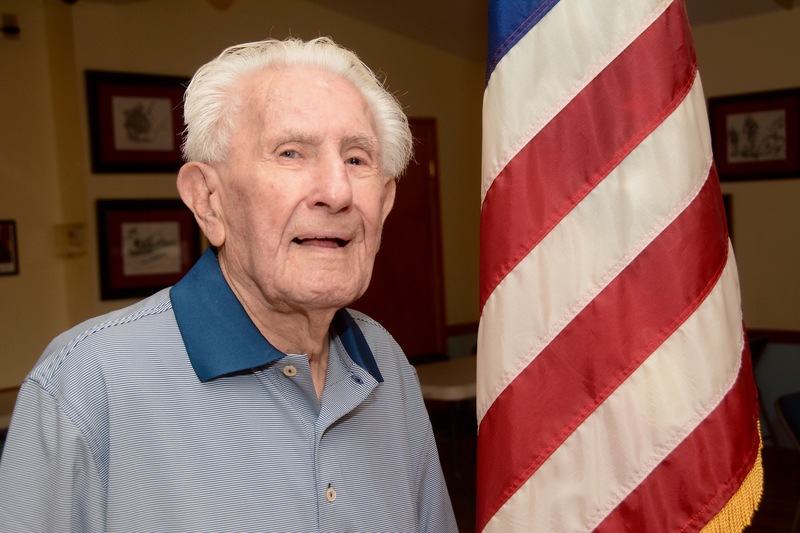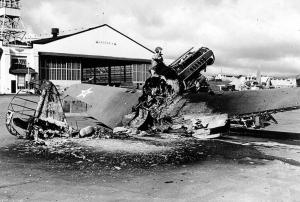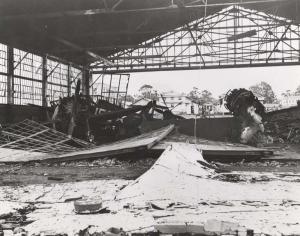Pat Patterson: Veteran pilot among first heroes of World War II
Edward “Pat” Patterson may be one of the last pilots alive to get airborne during the Japanese attack on the U.S. Navy base at Pearl Harbor. In the midst of the attack, only a handful of U.S. Army Air Corps pilots was able to find undamaged aircraft to take off from airfields on the base.
He also is one of the few veterans who can claim they saw action from the first day to the last day of World War II.
On that fateful day in December 1941, Patterson awoke to the sounds of bombs dropping on Wheeler Field. The 95-year-old recalls Dec. 7 vividly.
He spent the night of Dec. 6 in Honolulu, returning to base around 11:30 p.m. He said no one had a clue about what was to transpire less than eight hours later.
The 21-year-old had arrived at Pearl Harbor in April and spent most of his time training to fly a P-40 Warhawk, a plane he flew throughout World War II. Growing up in Pittsburgh, Pa., flying was nothing new to Patterson, who had been flying since he was 11 years old.
Patterson said the first wave of Japanese fighters came through Kolekole Pass about 7 a.m. and flew bombing runs in a figure eight above the base. It was devastation.
Patterson said on Dec. 6, the pilots had been ordered to place nearly all planes on the flight line for inspection. Planes were lined up wing to wing to maintain tight security around them.
The planes were easy targets for the Japanese. In two bombing and strafing waves, they hit the airstrips and hangars causing widespread damage.
After the first wave ended, Patterson and a few other pilots scrambled to get to their planes and took off in pursuit of the Japanese who were heading back to their carriers about 150 miles offshore. Patterson's plane was saved from destruction because it was one of two that was camouflaged.
Historical records differ on exactly how many pilots were able to take off and confront the Japanese, but at least 12 different pilots from across the island got airborne and shot down about two dozen Japanese planes. The pilots – some killed in action that day – have been called the first heroes of World War II. The list includes George Welch, who was born and raised in Wilmington. The highly decorated pilot died in 1954 during a test flight crash.
Patterson said he and other pilots chased the Japanese planes as far as they could before they had to turn around because of fuel limitations. He said only four planes were able to take off from Wheeler Field.
Surprise attack is devastating
Military records show that at Wheeler, 83 aircraft were destroyed, 38 men were killed and 59 men were wounded by 25 dive bombers that dropped about 35 bombs on the base hangars and airstrips. “They hit everything on the field and destroyed just about everything on the flight line,” Patterson said.
In all, of the 400 aircraft on Pearl Harbor, nearly half were destroyed and more than 160 aircraft were damaged. At the naval base, the Japanese hit all eight of the American battleships, sinking four, and also damaged or sank another eight ships. More than 2,400 Americans died during the surprise attack, and more than 1,170 were wounded.
More than 350 Japanese fighters, bombers and torpedo planes were launched from six aircraft carriers during the two waves of the attack.
Patterson said he returned to the base and had to land on the ground because the airstrips were filled with burning wreckage. “We quickly saw that it was a disaster,” he said.
Veteran pilot becomes an ace
It didn't take long for the airstrips to be cleaned off and for aircraft carriers to return to Pearl Harbor with new planes. “As bad as it was, luckily none of the carriers were in port during the attack,” Patterson said.
Patterson would go on to fly an amazing 362 sorties, shooting down eight enemy planes during the rest of the war. Five kills makes a pilot an ace.
He moved from island to island in the China-Burma-India Theater and the Southwest Pacific Theater toward Japan over the next four years flying escort missions for B-17 and B-24 bombers.
He said he had some close calls in his P-40 including two belly landings without wheels. “Sometimes P-40s had a little problem with their wheels coming down. I'm lucky to be here,” he says with a smile.
As Americans geared up for an invasion of Japan in 1945, Patterson said he never felt that would happen. He said he was aware of the possibility of an atomic bomb drop on Japan, but he said, nobody knew just how devastating the bomb was. He said he has a leaflet from President Harry Truman dropped on some Japanese cities in early August 1945 warning about the use of a second bomb following the attack on Hiroshima.
He takes his war record in stride. “We had a job to do, and we did it. We had trained for it, and we answered the call,” he said.
Retirement not in his future
After the war, Patterson stayed in the Air Force for another 13 years. He spent two years in Turkey with a crew of 30 teaching Turks how to fly and perform maintenance and load planes. He worked at the Pentagon for one year and worked in civil service in Japan in the late 1950s.
Patterson, who moved to the Lewes area 15 years ago with his late wife, Beverly, has worn many hats over the years and says he's still not retired. He spent many years as a construction superintendent building high-rise buildings in Washington, D.C., Maryland and Virginia, worked at a country club in Illinois and even at the age of 95, he works part time at Kings Creek Country Club in Rehoboth Beach.
Patterson last flew a plane in the 1990s and is looking forward to taking a ride in the historic, restored B-25 Panchito owned by the Delaware Aviation Museum Foundation. The ride was postponed when bad weather forced cancellation of Wings and Wheels at the Delaware Coastal Airport in Georgetown.
His adopted home has become American Legion Post 17 in Lewes where he recently transferred his membership.
Legion Secretary Kim Yost said Patterson came to the post for about a year before anyone realized his life's story. “He is quiet and humble and a real national treasure,” she said. “He's now started a friendship with all of us.”
The post hosted his 95th birthday party in July.
16 million served during World War II
As Veterans Day nears on Wednesday, Nov. 11, it's time to reflect on the fact that of the 16 million Americans who served their nation during World War II, only about 855,000 are still alive. Most surviving World War II veterans are in their mid-90s.

















































